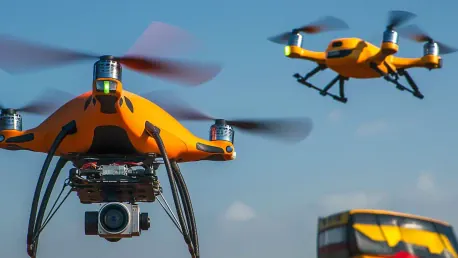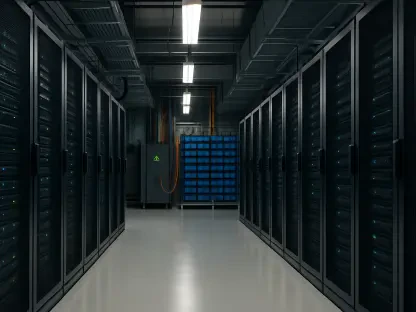Microdrones, scarcely larger than a fingernail, have been visualized as essential tools navigating through tight spaces in disaster-stricken areas for years. However, their immense potential in disaster response has been hindered by a formidable technological barrier—sustaining sufficient power for extended missions. Traditional batteries have proven too bulky and heavy, causing flight times to be severely limited to just a few minutes, which is inadequate for thorough search and rescue operations. However, a groundbreaking development by researchers at the University of California San Diego and CEA-Leti could very well be the game-changer that transforms these technological marvels into efficient lifesavers.
The Power Challenge
One prominent barrier that has consistently hampered the effective deployment of microdrones in disaster scenarios is their need for sustained power. The issue stems from the limited energy density provided by traditional battery technologies, which are not only bulky but also significantly weigh down these tiny devices. Even though lightweight lithium-ion batteries can deliver some power, they fall short in providing the requisite high voltages needed for optimal microdrone operation without the compromise of additional weighty components like inductors or capacitors. This limitation constrains microdrones to brief flights, a stark disadvantage in scenarios where prolonged functional periods are crucial.
Furthermore, many microrobots rely on piezoelectric microactuators requiring high voltage levels—often tens to hundreds of volts—far beyond the modest 4 volts supplied by standard lithium-ion batteries. This discrepancy necessitates additional components to boost voltage levels, ultimately contributing to inefficient weight management and curtailed operational time. The need for a compact, lightweight, yet high-energy-density power solution became glaringly evident, sparking intense research and innovation to reform microdrone technology’s battery and power configurations comprehensively.
Innovative Power Solutions
Addressing the fundamental power challenge faced by microdrones, researchers developed a pioneering self-sustaining circuit configuration combined with miniaturized solid-state batteries. This novel approach, detailed in a forthcoming research paper, represents a significant shift in how microdrones can be powered efficiently without the constraints imposed by traditional battery technologies. The innovation leverages solid-state batteries known for their ability to be miniaturized without sacrificing energy density—a critical attribute for these tiny flying machines. These batteries’ compact form factor and high energy density uniquely position them as the ideal power source for microdrones.
Central to this breakthrough is the “flying battery” configuration. This configuration allows keen adjustment of the battery setup, either connecting them in series for higher voltage or in parallel for enhanced energy capacity. This dynamic switching, occurring within milliseconds, ensures that the microdrones can quickly adapt to varying power requirements during operations without the burden of additional passive components. The agility and efficiency provided by this configuration markedly extend the operational time and versatility of microdrones, positioning them as significantly more effective tools for disaster response.
Efficiency and Energy Recovery
Incorporating an energy recovery mechanism is another sophisticated aspect of the innovative power solution for microdrones. This system’s design means the solid-state batteries can be recharged efficiently by leveraging the microactuators’ ability to function as capacitors. The energy discharged during microactuator operations can be stored and reused, effectively extending the battery life. This energy recovery process, akin to the regenerative braking employed in electric vehicles, enhances the system’s overall efficiency, ensuring minimal waste and optimal use of available energy.
The adiabatic recharging process, which occurs without significant heat transfer, plays a crucial role in further extending the system’s operational capacity. By minimizing energy loss through heat dissipation, this recharging approach ensures that much of the discharged energy is recaptured and reused. This significantly boosts the longevity of microdrones’ power systems, enabling longer missions and reducing the need for frequent battery replacements. Through this innovative coupling of solid-state battery technology with energy recovery mechanisms, researchers have created a sustainable, high-efficiency power solution tailor-made for the demands of disaster response operations.
Real-World Applications
The application of these technological advancements extends far beyond theoretical research. In real-world scenarios, microdrones equipped with these innovations could navigate through the tight, treacherous confines of collapsed buildings to detect hazards or locate trapped individuals. This transformative capability provides first responders with critical data in real-time, potentially saving numerous lives. The ability of these microdrones to operate continuously for more than 50 hours on a system weighing just 1.8 grams marks a significant leap from current limitations, where traditional microdrones often falter after a few minutes of flight.
The practical implications for disaster response teams are profound. Equipped with tiny yet powerful microdrones, first responders can quickly gather intelligence on hazardous environments without directly jeopardizing human lives. Such capabilities ensure faster, more informed decision-making during search and rescue missions. The lightweight, high-density power solutions provided by solid-state batteries offer a robust yet adaptable means of sustaining microdrone operations in the most demanding conditions. This not only enhances operational efficiency but also vastly improves the chances of successful rescue missions in the critical early hours after a disaster strikes.
Optimized Design and Future Potential
Custom-developed solid-state batteries from CEA-Leti promise even higher energy densities and further weight reduction, with prototype systems weighing just 14 milligrams. This impressive miniaturization and high energy density underscore the scalability of this technology, showcasing its potential for even greater efficiency improvements and higher voltage outputs in future iterations. The ability to scale down the weight while maintaining or even enhancing power capacity positions these batteries as the cornerstone of future microdrone innovations.
The flying battery configuration significantly contributes to the versatility and dynamism of the power management system. By allowing microdrones to adapt swiftly to varying energy demands, this setup ensures optimal performance across different operational scenarios. As researchers continue to refine and perfect these technologies, they open avenues for a broader range of micro-robotic applications. This advancement promises to revolutionize how microdrones are used in disaster response and beyond, paving the way for enhanced rescue missions and potentially transformative applications in various other fields, such as environmental monitoring and industrial inspections.
Expert Insights
Patrick Mercier, professor at UC San Diego and co-senior author of the study, stresses the critical importance of minimizing the weight of microdrone components to achieve maximum flight time. Mercier highlights that the drive to reduce weight involves a delicate equilibrium. Heavier components, even those designed to boost operational efficiency, can drastically limit the functional duration of microdrones. This underscores the necessity of innovative lightweight solutions that do not compromise performance.
Gaël Pillonnet, scientific director at CEA-Leti and co-senior author, points out the unique capability of solid-state batteries to be miniaturized without losing energy density. According to Pillonnet, the team’s strategy of dividing a large battery into multiple smaller units, each maintaining the same energy density as the original large battery, is a significant innovation. This clever adaptation allows for the flexibility and efficiency necessary to power these tiny, highly capable machines without incurring the penalties of increased weight and reduced operational time.
Implications for Disaster Response
For years, microdrones, barely larger than a fingernail, have been envisioned as crucial tools for navigating tight spaces in disaster-stricken areas. Despite their potential in disaster response, they have faced a significant technological hurdle—maintaining enough power for long missions. Traditional batteries are too bulky and heavy, resulting in flight times that last only a few minutes, which is insufficient for comprehensive search and rescue operations. However, researchers at the University of California San Diego and CEA-Leti have made a groundbreaking development that could change everything. They have created new technology that promises to keep these tiny drones powered much longer, making them efficient lifesavers in disaster scenarios. By overcoming the power limitations, this innovation could finally allow these small drones to fulfill their promising role in disaster response, enhancing their ability to assist in thorough search and rescue missions, and potentially saving numerous lives in the process.









